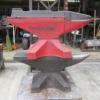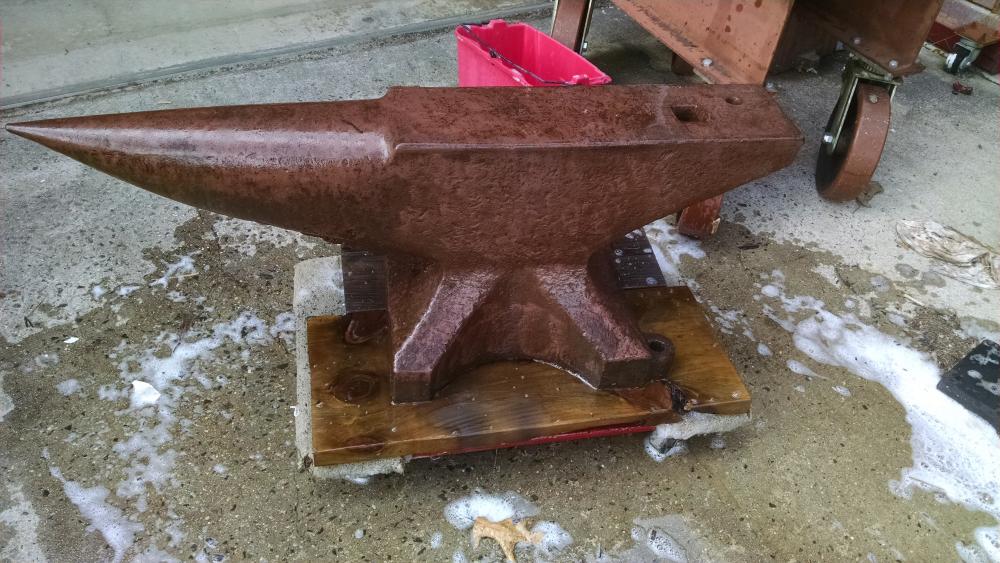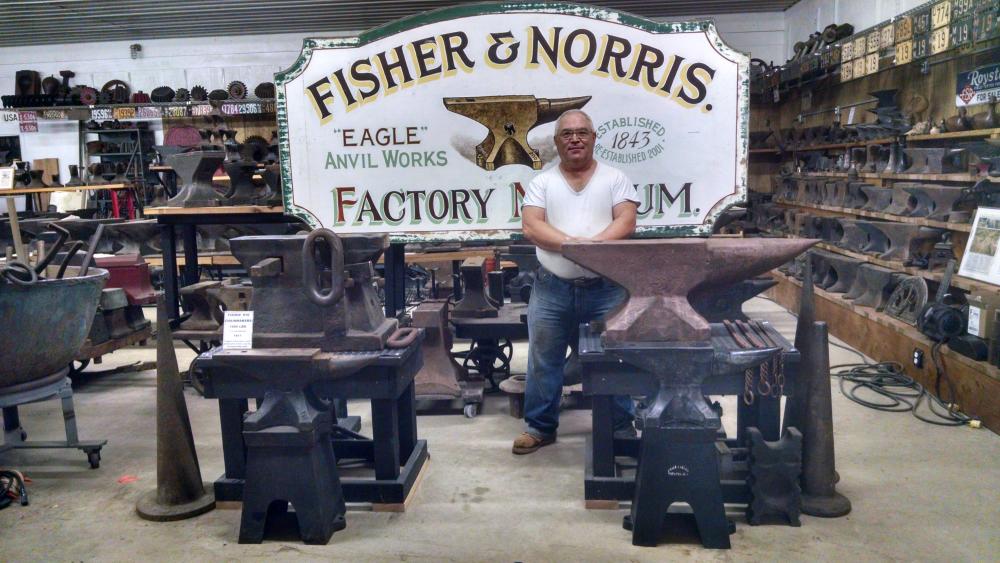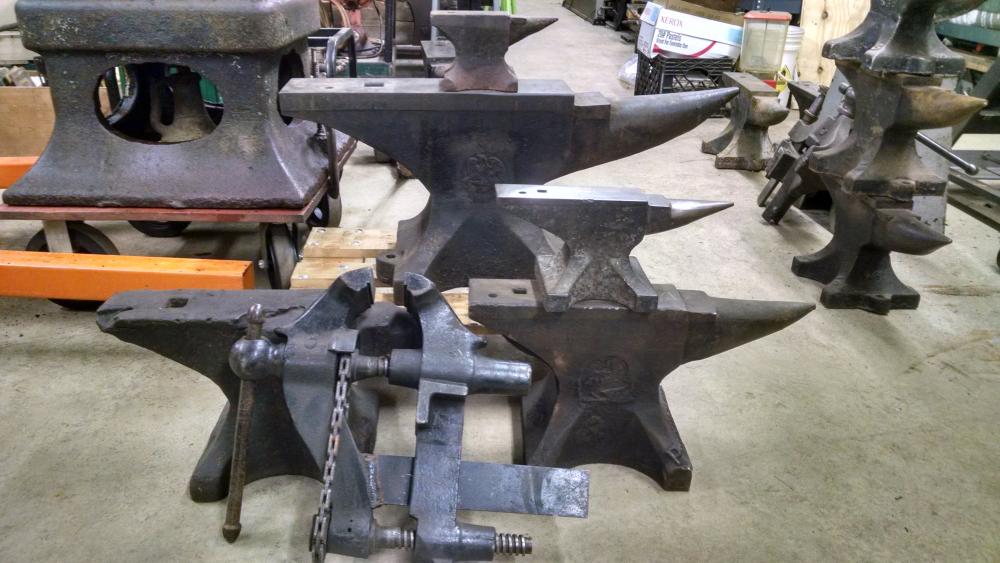-
Posts
2,481 -
Joined
-
Last visited
Content Type
Profiles
Forums
Articles
Gallery
Downloads
Events
Everything posted by njanvilman
-
Just message me here or at njanvilman@gmail.com. Easy trip...80 minutes from the Tappen Zee Bridge. Open by appt. most times except weekends in December, unless you are here for a Christmas tree.
- 661 replies
-
- Cast anvil
- Fisher & Norris
-
(and 1 more)
Tagged with:
-

Anvils: A beginner buyers guide
njanvilman replied to Everything Mac's topic in Anvils, Swage Blocks, and Mandrels
Or if in New Jersey, ANVILS. -
The name Fisher & Norris was stamped into the top side of some of the early anvil made in Trenton, NJ. I have never seen any marked "Maine". The only markings of some of the Maine made Fisher's is the weight stamped in. In the 1860's, Fisher began casting in the Eagle holding wheat stalks, similar to US coinage, as their logo. That changed around 1871 when Clark Fisher took over and changed the logo to the Eagle on a Naval Anchor. A few variations of that logo were used to the end.
-
I moved over 3000 lb of iron last week. And spent yesterday sawmilling logs. But I still work out when I can.
- 661 replies
-
- Cast anvil
- Fisher & Norris
-
(and 1 more)
Tagged with:
-
I recently add this CUSTOM Fisher anvil to the Fisher & Norris Factory Museum collection. Specs: 640 lb 43" long Horn 20", it is over 8" diameter where it meets the body Made in 1900 There is very little use on the anvil. Second photo shows the anvil on display at the entrance to the museum. #10 Fisher Chainmaker's on the left, and this Custom on the right. And lots more.
- 661 replies
-
- Cast anvil
- Fisher & Norris
-
(and 1 more)
Tagged with:
-
Fisher saw anvils were designed to be use with a cold circular saw blade. The technician would tune the blade according to many factors: hp driving the saw, left or right, # teeth, and type of wood usually sawing. The blade was always between the anvil and the hammer. You can use hot metal on the anvil. It will not affect it. Just remember that the face of the anvil is usually very hard, somewhere around Rockwell 60, and can be prone the chipping or cracking. Be sure to aim you blows carefully.
- 661 replies
-
- Cast anvil
- Fisher & Norris
-
(and 1 more)
Tagged with:
-
Fisher sawmaker's anvils were never intended to be hit with a hammer, or be used with hot metal. Their use was under a circular saw blade, used when the saw master was tuning the blade, done cold. Their faces were hardened when made, but never had to be as hard as a regular anvil. However, in time, the face did work harden. I have some saw anvils that have faces that are around Rockwell 58.
- 661 replies
-
- Cast anvil
- Fisher & Norris
-
(and 1 more)
Tagged with:
-

A nice Fisher I will have tomorrow
njanvilman replied to JT's topic in Anvils, Swage Blocks, and Mandrels
It is a FISHER. Probably made in the 1950's. It could have had a paper label on the "back" side when shipped. Most of these did not survive. They were just stuck on like a postage stamp, and easily got damaged or fell off. For whatever reason, I have never seen a Fisher with a date after 1951, and many also did not have the Eagle or Fisher on the front. -
The line of London pattern anvils in the museum goes up to the 800 lb. No, I have not found a 1000 lb of that type. Fisher listed the size in their brochure, but I have never found any reference to one. I was referring to the #10 Fisher chainmakers, which does tip the scale at just under 1000 lb. It is the heaviest anvil Fisher produced that I know of, besides the BIG Centennial Anvil. That one is located in the NJ State Museum. Someday I hope to borrow it to bring to big blacksmithing events.
- 661 replies
-
- Cast anvil
- Fisher & Norris
-
(and 1 more)
Tagged with:
-

A nice Fisher I will have tomorrow
njanvilman replied to JT's topic in Anvils, Swage Blocks, and Mandrels
It is probably 100 lb., according to my spec sheet. -
Most people understand and know that most of the collection will be set free in a few years. Biggest problem is figuring out what to do with the original Fisher patterns and other things. It would be terrible to break up that part of the collection. Yes, everyone wants to take home a souvenir, but no one has figure out how to carry out the 1000 lber yet.
- 661 replies
-
- Cast anvil
- Fisher & Norris
-
(and 1 more)
Tagged with:
-
There is security. It would be difficult. Leave it at that.
- 661 replies
-
- Cast anvil
- Fisher & Norris
-
(and 1 more)
Tagged with:
-
Hartford is just an easy three hour drive away. Worth the trip.
- 661 replies
-
- Cast anvil
- Fisher & Norris
-
(and 1 more)
Tagged with:
-
We have had a few minor quakes here in the East, but I swear I did not cause them. Just a bit o' iron here. My stacks of smalls are the ones I worry about. I am bringing home a couple of bit missing anvils from the line shortly. It will almost complete the collection of most known styles Fisher made.
- 661 replies
-
- Cast anvil
- Fisher & Norris
-
(and 1 more)
Tagged with:
-
My FISHER items brought home from Quad States 2016 for the Fisher & Norris Factory Museum. Starting at the top: a #1 size 1850's Fisher, about 10 lb; under it is a near mint 300 lb Fisher, dated 1941; to the right is a 40 lb, 1938 Fisher with different markings than usual; under it is a 1882, 135 lb is good shape; to the left on the floor is a badly battered 150 lb, bought for examples of my rating system in my future book, and finally a #3 Early double screw vise. All of these pieces are in the building, and will slowly be organized into the exhibits. It is very tempting to buy other stuff at Quad States, but I was good and only brought home Fisher stuff.
- 661 replies
-
- Cast anvil
- Fisher & Norris
-
(and 1 more)
Tagged with:
-

Fisher anvil before and after cleaning
njanvilman replied to Rayman1975's topic in Anvils, Swage Blocks, and Mandrels
Your anvil was made in the 1870's. -

Old English - Question
njanvilman replied to Ricko Lynge's topic in Anvils, Swage Blocks, and Mandrels
You have what is often called a "Double Arch" anvil. It is not a saw anvil. Many early anvils were made without a horn. Do not "fix" anything on the anvil. It has survived over 150 years as is. You will ruin it. Use it gently, or just take the rest of the paint off and admire it. And join the ranks of anvil collectors, those of us preserving our industrial past. It is a wonderful piece. -
Does it have FISHER on the front base, under the horn? Is there a date under the heel on the sloping part? Sure looks like a Fisher. Not all had Eagles. I probably is a Fisher, and the price was right! The anvil looks to be in great shape too. Very little use on it.
-
Three years ago there had to be over 300 post vises for sale at QS. Some big ones and little ones sold. Most went home with the sellers. I tried to sell a heavy 6" all week, finally lowering the price to $100 on Saturday. It did not sell. I brought it home and gave it away to a good friend who needed one. So one never knows what everyone will show up with. Get there early, bring cash, and buy if you want it. Come back even a few minutes later and it might be gone.
-
It is definitely a cast anvil. You can see the parting line on the face. What it is made from is the determining factor whether it is a user or an anchor. Cast iron= junk. Steel = good.
-
Your anvil was cast in the 1870's. Do not machine anything. Use a wire wheel cup brush to clean off the rust. Then spray it with a light oil. If you need a better edge, make a saddle to drop on the anvil and use that. Or turn the anvil with the horn to the right, and use the good edge. The line might or might not be a crack. Die penetrant is a good idea, just to know. I doubt that it will affect the anvil use. If it is a crack, it has been there a long time. Any other questions?
-

Trenton Anvil? (or A&H or ?)
njanvilman replied to Steamboat's topic in Anvils, Swage Blocks, and Mandrels
The way the weight and serial # are marked suggest a Trenton. -
Face looks flat, edges have some wear. Horn looks good. The early HB are not as elegant as later ones, but as a user, it should be OK. It will all come down to price. If you can get it for a competitive price, and decide to flip it, you might be able to make some $$ on it toward other stuff. And we all know how blacksmiths like metal stuff: tools, etc.
-
Your HB anvil is from 1893, the second year of production, according to AIA.



